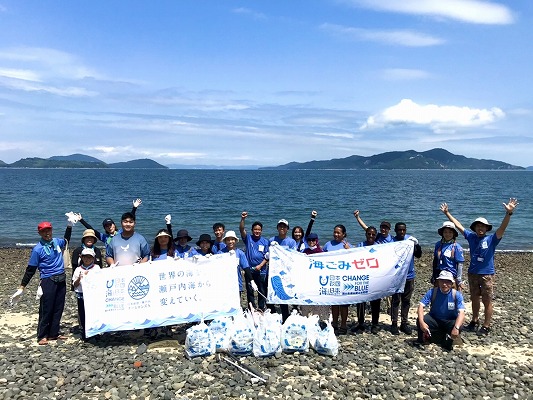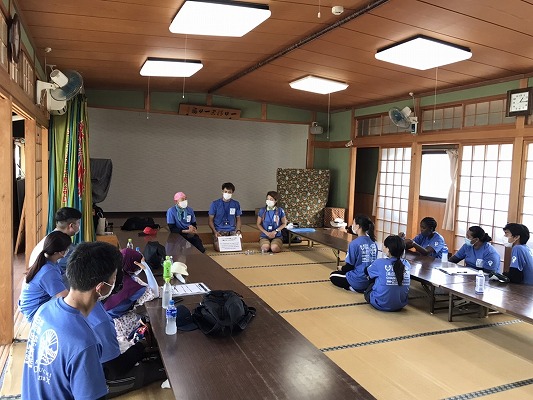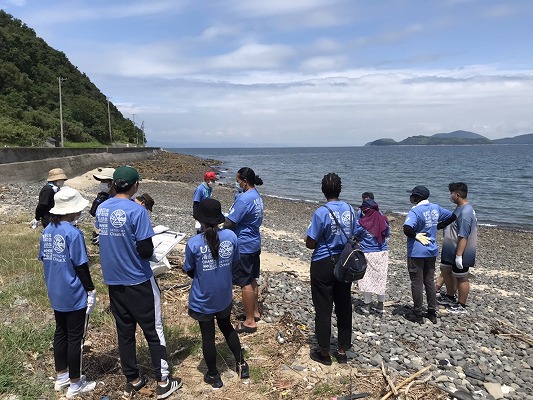2022年8月21日(日)、本学インターナショナルオフィスは、Change For The Blue in かがわ実行委員会と連携し、「離島(佐柳島)海洋ごみ清掃・調査活動」を実施しました。Change For The Blueは日本財団「海と日本プロジェクト」が推進しており、本行事は「瀬戸内海の海洋ごみ問題の知識が少ない学生を対象に、実際に海岸清掃を体験し、島民や漁師の声を聞くことにより知識を深め、学内でのプラごみ削減に向けた施策を検討するため」に実施されました。
参加者は、Change For The Blue in かがわ実行委員会のメンバー及び関連する瀬戸内オーシャンズXの関係者に加え、本学留学生が9名、本学教員が2名(本学関係者は計11名)でした。
内容は、以下の部分から構成されました。
①底引き網漁の見学
②海ごみの講義
③海岸清掃
④海ごみの種類及び重量の調査
⑤元漁師による講話
移動手段はChange For The Blue in かがわ実行委員会により準備された海上タクシーで、高松港から佐柳島へ移動する間に①を実施、佐柳島にて②から④を実施、高見島に移動して⑤を実施、という流れになりました。
①においては、地元漁師の協力により、実際に底引き網漁をどのように行うかを見学することができました。海上タクシーを漁船の近くに寄せ、網を引き上げて魚を捉える様子を見ることができました。
②においては、瀬戸内海の海洋汚染の実態、陸からのプラスチックごみ等が話題として取り上げられました。
③④では、海岸のごみを回収しながら、ごみの種類及び重量の調査を実施しました。
多く回収されたものは、飲料用プラボトル・ペットボトル(64)とプラスチック・発泡スチロール梱包材(53)、食品の包装・袋(14)でした。また、合計の袋数は14で、重さは25.8㎏でした。
⑤は、高見島在住の元漁師に、島の歴史、漁師としての活動、当時の船員の状況などを伺うことができました。
今回の企画における上記のいずれも、交通手段から企画内容まで他では得がたいものであり、参加した留学生にとっては貴重な学習及び体験の機会となりました。
On August 21, 2022 (Sunday), the ‘Change for The Blue in Kagawa’ Executive Committee collaborated with the International Office of the university to conduct the "Remote Island (Sanagishima) Marine Garbage Cleanup and Survey Activity".
Change for The Blue is a vehicle established by the Nippon Foundation to promote the "Umi to Nihon Project", literally ‘Japan and the Sea Project’. The activity offered a good opportunity for students to acquire and deepen knowledge on the marine garbage environment and to subsequently contemplate on measures to reduce plastic waste on campus.
In addition to the members of the executive committee and personnel from Setouchi Oceans X, the participants were nine international students from our university and two faculty members (total of 11 people to our university).
The activity consisted of the following components:
①Observation of trawl fishing method
②Lecture on marine garbage
③Coastal cleaning
④Survey of marine garbage
⑤Talk event by a former fisherman
The means of transportation was a sea taxi prepared by the executive committee. ① was carried out while traveling from Takamatsu Port to Sanagijima while ② to ④ were carried out at Sanagijima and ⑤ was carried out at Takamijima.
In (1), with the cooperation of local fishermen, students could observe how trawling is actually carried out. Students were able to watch as the sea taxi went close to the fishing boats which were pulling up the nets filled with fish catch.
In (2), the lecture content focused on the actual situation of marine pollution at the Seto Inland Sea and how plastic waste from the land ended up at the sea.
In (3) and (4), after collecting garbage from the coast, the students surveyed the garbage types and have the weights recorded. The top items collected were plastic beverage bottles (64), other plastic/foam packaging materials (53), and food wrappers (14). Total number of bags were 14, weighing 25.8 kgs.
For (5), a former fisherman living in Takamijima, gave a talk about the history of the island, his activities as a fisherman, and the situation of sailors at a bygone era.
There are very few opportunities for international students to experience all the five components of this activity, including that of riding on a sea taxi and the talk by the former fisherman. No doubt, the students who participated in the event benefited from this valuable learning experience.


